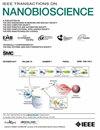金纳米粒子腹腔注射对小鼠红细胞和肾组织的影响
IF 4.4
4区 生物学
Q1 BIOCHEMICAL RESEARCH METHODS
引用次数: 0
摘要
本研究旨在探讨通过腹腔注射(IP)给药的两种不同类型的金纳米粒子(AuNPs)对小鼠模型的血液和肾脏组织变化的影响。实验使用了三组 15 只成年雄性 BALB/c 健康小鼠(体重约 25-30 克),分别命名为 G1、G2 和 G3。G1 小鼠接受药物治疗,而 G2 和 G3 则分别接受 10 mg/kg 体重的甲氧基聚乙二醇金纳米颗粒(PEG-AuNPs)和荧光染料标记金纳米颗粒(Dye-AuNPs)的 IP 注射。血液学参数根据标准全血细胞计数(CBC)技术进行测量。除对血红蛋白(HBG)水平无显著影响外,PEG-AuNPs 和 Dye-AuNPs 这两种纳米粒子能显著降低各组的大多数红细胞(RBC)参数。与对照组相比,PEG-AuNPs 和 Dye-AuNPs 这两种金纳米粒子都会导致红细胞计数、平均血球容积 (MCV) 和平均血红蛋白 (MCH) 水平降低。值得注意的是,Dye-AuNPs 和 PEG-AuNPs 导致 RBC 分布 RDW-(CV % 和 SD fL)显著升高。肾小球损伤是基于肾小管内出现水肿变性和富含蛋白质的液体。肾组织和血液指数在两种纳米颗粒的作用下发生了显著变化,表明可能存在器官损伤。本文章由计算机程序翻译,如有差异,请以英文原文为准。
Impact of Gold Nanoparticles Intraperitoneal Injection on Mice’s Erythrocytes and Renal Tissue
The purpose of this study was to investigate the effects of two different types of gold nanoparticles (AuNPs) delivered by intraperitoneal (IP) injection on blood and kidney tissue changes in a mouse model. Three groups of fifteen adult male BALB/c healthy mice, weighing approximately 25- 30 g, were used for the experiment and designated G1, G2, and G3, respectively. G1 mice received vehicle, whereas G2 and G3 received an IP injection of 10 mg/kg body weight of methoxy poly ethylene glycol gold nanoparticles (PEG-AuNPs) and fluorescently dye labeled gold nanoparticles (Dye-AuNPs), respectively. Hematological parameters were measured based on the standard complete blood cell count (CBC) technique. The two nanoparticles, i.e., PEG-AuNPs and Dye-AuNPs, significantly reduced most red blood cell (RBC) parameters in the groups with the exception of a nonsignificant effect on hemoglobin (HBG) levels. Both gold nanoparticles, i.e., PEG-AuNPs and Dye-AuNPs, led to a reduced RBC count, mean corpuscular volume (MCV), and mean corpuscular hemoglobin (MCH) level when compared with the control. Notably, Dye-AuNPs and PEG-AuNPs resulted in a considerably higher RBC distribution RDW- (CV % and SD fL). Glomerular injury was suggested based on the development of hydropic degeneration and the presence of a protein-rich fluid inside the tubules. Renal tissue and blood indices changed significantly in response to the two nanoparticles, suggesting possible organ injury.
求助全文
通过发布文献求助,成功后即可免费获取论文全文。
去求助
来源期刊

IEEE Transactions on NanoBioscience
工程技术-纳米科技
CiteScore
7.00
自引率
5.10%
发文量
197
审稿时长
>12 weeks
期刊介绍:
The IEEE Transactions on NanoBioscience reports on original, innovative and interdisciplinary work on all aspects of molecular systems, cellular systems, and tissues (including molecular electronics). Topics covered in the journal focus on a broad spectrum of aspects, both on foundations and on applications. Specifically, methods and techniques, experimental aspects, design and implementation, instrumentation and laboratory equipment, clinical aspects, hardware and software data acquisition and analysis and computer based modelling are covered (based on traditional or high performance computing - parallel computers or computer networks).
 求助内容:
求助内容: 应助结果提醒方式:
应助结果提醒方式:


